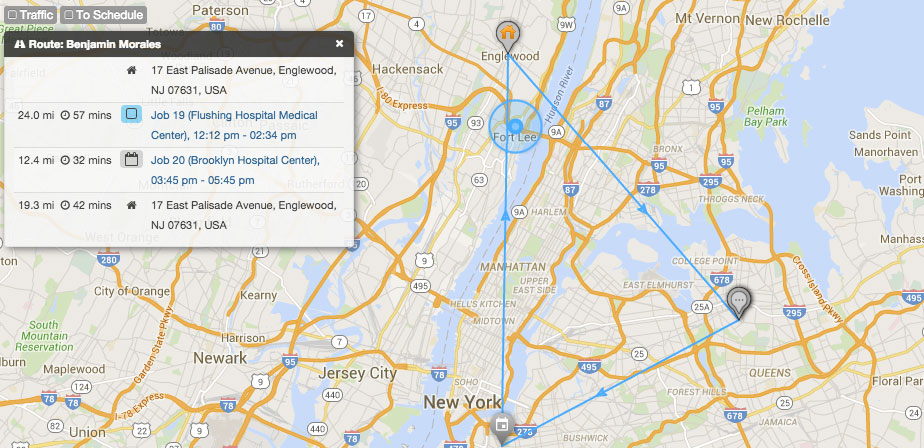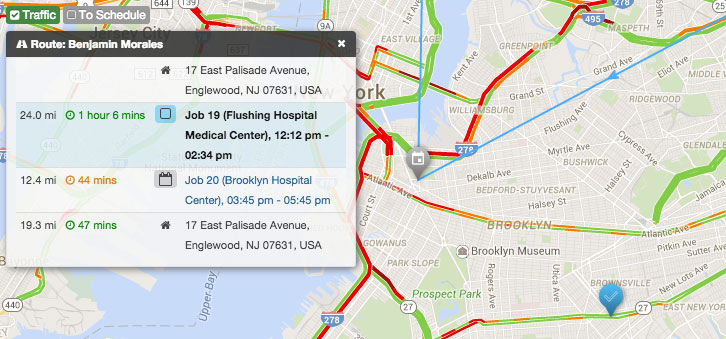One of the greatest advantages of field service embracing technology to aid workforce management is the use of what’s known as map view dispatch – in other words, the ability to see and manage all of your technicians and jobs on a digital map. It sounds simple, doesn’t it? Yet map view dispatch transforms scheduling from a task done with clipboards and post-it notes into an easy, efficient, time and money saving process. The technology that underpins it all is geolocation.
What is geolocation?
Geolocation is the technology used to identify the real-world location of things, such as mobile devices and, by default, the person with that device. Nearly all smartphones, tablets and mobile devices come with inbuilt GPS (Global Positioning System) in the form of a chip, and when this chip is receiving 3 or more signals from the 31 GPS satellites orbiting the Earth, these signals can be used to determine the device’s location to within 10m.

Geolocation then works in two ways: by reporting your location, and by associating other real-world locations to yours, putting you in real-time geographical context.
I get the theory, but what does that mean in practice?
For social media users, this means being able to ‘check in’ remotely at destinations like bars, restaurants or landmarks, and to find nearby places and events. Geolocation enables drivers to find the fastest route home, avoiding traffic jams, and fitness bracelet users to record their running routes (and boast about them online). It points singletons in the direction of the nearest available date and even lets overbearing parents keep tabs on their kids with family-locating apps.
But geolocation isn’t just about tracking down teenagers at illegal raves, or finding the nearest date or sandwich. It has also been on the field service scene since 2005, and the accuracy of geolocation is getting better with every new generation of mobile device. That means that its potential uses for field service are only just being explored.
Enter map view dispatch…
The benefits of geolocation-powered map view dispatch
By using geolocation to track the whereabouts of technicians in real time, map view dispatch enables managers to visualize where their workforce is in relation to jobs that need doing. Rather than sifting through notes and making phone calls, they can make quick, informed decisions about which technicians to send to which job, and dispatch that technician at the touch of a button.
And managers aren’t the only ones who benefit from map view dispatch: if you’ve ever been on the receiving end of a call from an angry client who’s been waiting hours for a technician, you’ll know what a relief it would be to be able to tell that client exactly when their technician will arrive, even forecasting delays caused by traffic. No more long waits, and better communication means happier clients (and far fewer angry phone calls).

Using map view dispatch can also reduce travel time for technicians. For example, instead of tacking less urgent jobs onto the end of a technician’s shift, those jobs can be allocated depending on which technician is closest, cutting travel times and petrol costs.
If parts are needed throughout the day, they can be located as near to the technician as possible, whether that’s at a depot or with another technician working in the same area. Knowing who’s in the area can also encourage teamwork, with more experienced technicians able to help nearby colleagues with difficult jobs.
In terms of workforce productivity, geolocation also has the benefit of enabling managers to analyze the most efficient routes to jobs and see where technicians are straying off-route, or taking overly long breaks. With arrival and departure times also logged, billing for time spent on jobs becomes far more accurate.
Sounds great! Where can I find out more?
Geolocation, GPS tracking and map view dispatch are all features of Synchroteam, our cloud-based mobile workforce management tool. You can find out more about how it works here, and if you’re keen to try it out, sign up for a free trial here!
Lost Lego man header image thanks to Clement127.




